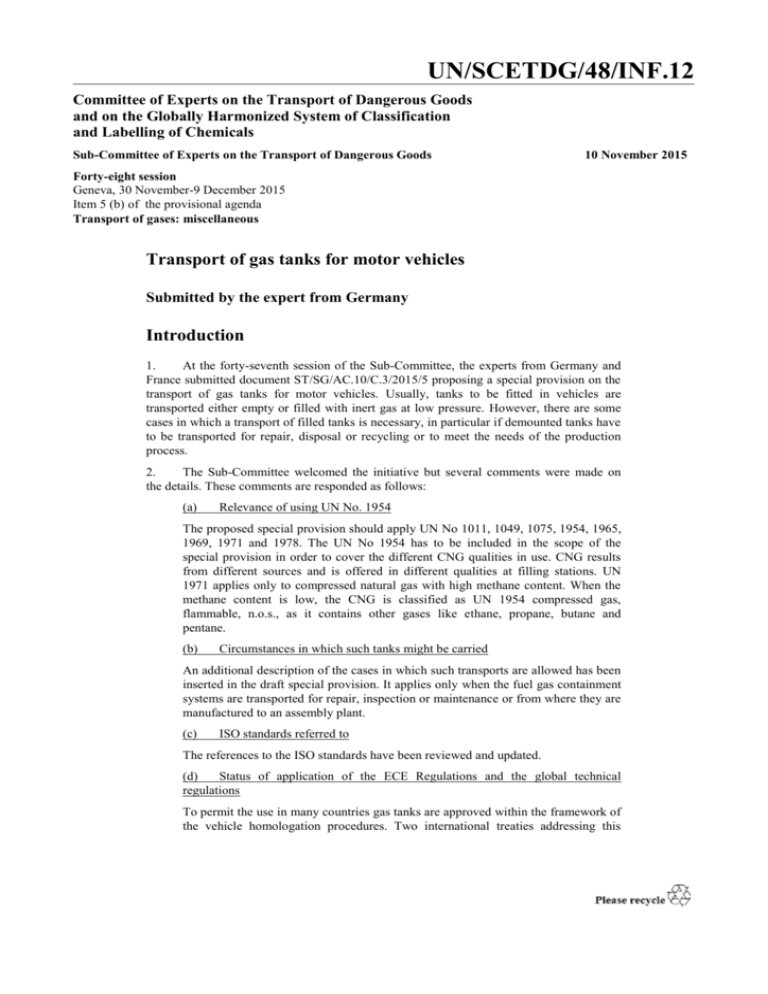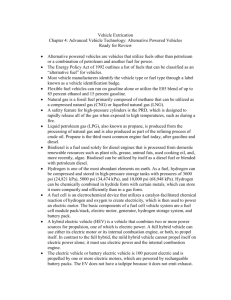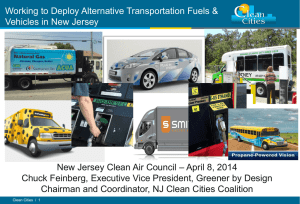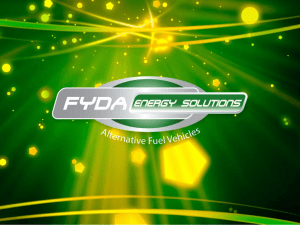un/scetdg/48/inf.12
advertisement

UN/SCETDG/48/INF.12 Committee of Experts on the Transport of Dangerous Goods and on the Globally Harmonized System of Classification and Labelling of Chemicals Sub-Committee of Experts on the Transport of Dangerous Goods 10 November 2015 Forty-eight session Geneva, 30 November-9 December 2015 Item 5 (b) of the provisional agenda Transport of gases: miscellaneous Transport of gas tanks for motor vehicles Submitted by the expert from Germany Introduction 1. At the forty-seventh session of the Sub-Committee, the experts from Germany and France submitted document ST/SG/AC.10/C.3/2015/5 proposing a special provision on the transport of gas tanks for motor vehicles. Usually, tanks to be fitted in vehicles are transported either empty or filled with inert gas at low pressure. However, there are some cases in which a transport of filled tanks is necessary, in particular if demounted tanks have to be transported for repair, disposal or recycling or to meet the needs of the production process. 2. The Sub-Committee welcomed the initiative but several comments were made on the details. These comments are responded as follows: (a) Relevance of using UN No. 1954 The proposed special provision should apply UN No 1011, 1049, 1075, 1954, 1965, 1969, 1971 and 1978. The UN No 1954 has to be included in the scope of the special provision in order to cover the different CNG qualities in use. CNG results from different sources and is offered in different qualities at filling stations. UN 1971 applies only to compressed natural gas with high methane content. When the methane content is low, the CNG is classified as UN 1954 compressed gas, flammable, n.o.s., as it contains other gases like ethane, propane, butane and pentane. (b) Circumstances in which such tanks might be carried An additional description of the cases in which such transports are allowed has been inserted in the draft special provision. It applies only when the fuel gas containment systems are transported for repair, inspection or maintenance or from where they are manufactured to an assembly plant. (c) ISO standards referred to The references to the ISO standards have been reviewed and updated. (d) Status of application of the ECE Regulations and the global technical regulations To permit the use in many countries gas tanks are approved within the framework of the vehicle homologation procedures. Two international treaties addressing this UN/SCETDG/48/INF.12 subject were concluded under the auspices of the United Nations Economic Commission for Europe (UNECE): • The 1958 Agreement concerning the adoption of uniform technical prescriptions for wheeled vehicles, equipment and parties which can be fitted and/or be used on wheeled vehicles and the conditions for reciprocal recognition of approvals granted on the basis of these prescriptions, and its addenda hereafter called “ECE Regulations”; • The 1998 Agreement concerning the Establishing of Global Technical Regulations for wheeled vehicles, equipment and parts which can be fitted and/or be used on wheeled vehicles, (and the Global Technical regulations (GTRs) established pursuant to this Agreement). The status of application of the UN Regulations Nos. 67, 110, 115 is indicated in document UN/SCETDG/47/INF.52. Even if not all countries of the world apply the ECE Regulations and the global technical regulations, the tanks might be transported internationally. When the country of manufacture is different from the country of use, the tanks nevertheless has to comply with the regulations of the country in which the vehicle will be approved and used. (e) Possibility of referring to other national standards On the basis of information from the industry and the expert from the USA, the following standards have been identified as relevant for the USA: LPG related: • NFPA 58 Liquefied Petroleum Gas Code, Chapter 11 – states “Containers shall be designed, fabricated, tested, and marked (or stamped) in accordance with the regulations of the U.S. Department of Transportation (DOT); the ASME Boiler and Pressure Vessel Code, Section VIII, “Rules for Construction of Unfired Pressure Vessels”; or the API-ASME Code for Unfired Pressure Vessels for Petroleum Liquids and Gases, except for UG125 through UG-136.” CNG related • NFPA 52 Vehicular Gaseous Fuel Systems Code (refers to CNG and LNG) • FMVSS 304 Compressed Natural Gas Fuel Container Integrity • ANSI NGV2, American National Standard for Compressed Natural Gas Vehicle Fuel Containers • CGA C-6.4 methods for External Visual Inspection of Natural Gas Vehicle and Hydrogen Vehicle Fuel Containers and their Installation (referenced in NGV2) Hydrogen Related: 2 • SAE J2579 Standard for Fuel Systems in Fuel Cell and Other Hydrogen Vehicles • UN Global Technical Regulation No. 13 for Hydrogen and Fuel Cell Vehicles • ANSI HGV 2-2014 - Compressed hydrogen gas vehicle fuel containers UN/SCETDG/48/INF.12 • CGA C-6.4 methods for External Visual Inspection of Natural Gas Vehicle and Hydrogen Vehicle Fuel Containers and their Installation For the time being, no national standards have been included in the draft special provision. The issue has to be further reviewed, in particular with regard to the content of the standard and the question whether international transport takes place for vehicle tanks complying to national standards only. (f) The need to take liquefied natural gas (LNG) into account Requirements for LNG components have been incorporated into ECE R 110. However, the insulation of LNG tanks might not be sufficient to keep the necessary temperature level to prevent a discharge of overpressure through the venting system during longer transport. The minimum design hold time of vehicle LNG tanks is not more than 5 days. With regard to possible longer transport durations, in particular in sea transport, this seems not sufficient to ensure a safe transport in all modes of transport on the basis of the UN Model Regulations. Solutions for LNG tanks should be established in modal or regional provisions, as appropriate. (g) The use of steel tanks The question arose as detailed information on tanks made of composite materials was given in document ST/SG/AC.10/C.3/2015/5. For hydrogen, only all composite containers will be used as they have several advantages, but metal containers are used for LPG and CNG vehicles. ECE R 110 mentions for CNG the following types: • CNG-1 Metal • CNG-2 Metal liner reinforced with resin impregnated continuous filament • (hoop wrapped) • CNG-3 Metal liner reinforced with resin impregnated continuous filament • (fully wrapped) • CNG-4 Resin impregnated continuous filament with a non-metallic liner • (all composite) Thus, the proposed special provision applies to all of these types of vehicle tanks. (h) Filling limits Filling limits usually may not be complied with if the demounted tank is transported for repair, disposal or recycling. When a tank is replaced at a repair shop, this shop usually does neither have the equipment needed to empty the tank completely nor the equipment to measure the actual filling ratio. A filling limit can be applied only if the (hydrogen) tanks are transported in the production process from the manufacturing place to the assembly plant. As the tanks are designed for different pressures, a pressure limit is not appropriate, but a filling limit of not more than 20 % SOC have been inserted in the draft special provision. (i) Equivalence of safety levels between the requirements of the Model Regulations for pressure receptacles and those of vehicle construction regulations and standards The ECE Regulations and ISO standards for CNG and LPG tanks and the GTR provide a high level of safety (Annex of document ST/SG/AC.10/C.3/2015/5 shows selected test requirements). The tests were developed to demonstrate that the tank is capable of performing critical functions. These comprise functions related to the 3 UN/SCETDG/48/INF.12 usage of a vehicle including fuelling/de-fuelling, parking in extreme conditions and performance in a fire. Manufacturers are expected to monitor the reliability, durability and residual strength of representative production units throughout the entire life of a vehicle. In the case of fire the gas will be released through a valve and and no explosion will occur. The same vehicle tanks which are subject of this proposal are transported all over the world when installed in vehicles. The aim of this proposal is to establish appropriate transport conditions for demounted tanks and to regulate defined cases of transport. It is important to prevent obstruction of pressure relieve devices and damage to pressurized parts of the fuel tank containment system. The containment systems should be properly secured. The appropriate requirements are laid down in letter d of the draft special provision. In this context also the discussion on dangerous goods in machinery, apparatus or articles, N.O.S should be taken into consideration. Without the insertion of new specialized provisions for gas tanks for vehicles, they might be consigned as dangerous goods in articles in future. Proposal 3. Amend the Model Regulations as follows: Chapter 3.2 Dangerous Goods List For UN No 1011, 1049, 1075, 1954, 1965, 1969, 1971, 1978 add special provision xxx in column 6 Add the following special provision "xxx" to Chapter 3.3: "xxx For the transport of fuel gas containment systems designed and approved to be fitted in motor vehicles containing this gas the provisions of sub-section 4.1.4.1, Chapter 5.2, Chapter 5.4 and Chapter 6.2 of these Regulations need not be applied when transported for repair, inspection or maintenance or from where they are manufactured to an assembly plant, provided the following conditions are met: (a) The fuel gas containment systems shall meet the requirements of ECE Regulation No. 67 Revision 21 or ECE Regulation No. 1152 in case of LPG tanks, ECE regulation No. 110 Revision 13 or ECE Regulation No. 1154 or ISO 11439/ISO 1 ECE Regulation No. 67 (Uniform provisions concerning: I. Approval of specific equipment of motor vehicles using liquefied petroleum gases in their propulsion systems; II. Approval of a vehicle fitted with specific equipment for the use of liquefied petroleum gases in its propulsion system with regard to the installation of such equipment) 2 ECE Regulation No. 115 (Uniform provisions concerning the approval of: I. Specific LPG (liquefied petroleum gases) retrofit systems to be installed in motor vehicles for the use of LPG in their propulsion systems; II Specific CNG (compressed natural gas) retrofit systems to be installed in motor vehicles for the use of CNG in their propulsion system) 3 ECE Regulation No. 110 (Uniform provisions concerning: I. Specific components of motor vehicles using compressed natural gas (CNG) in their propulsion system; II. Vehicles with regard to the installation of specific components of an approved type for the use of compressed natural gas (CNG) in their propulsion system) 4 ECE Regulation No. 115 (Uniform provisions concerning the approval of: I. Specific LPG (liquefied petroleum gases) retrofit systems to be installed in motor vehicles for the use of LPG in their propulsion systems; II Specific CNG (compressed natural gas) retrofit systems to be installed in motor vehicles for the use of CNG in their propulsion system) 4 UN/SCETDG/48/INF.12 155005 in case of CNG tanks, the Global Technical Regulation (GTR) No. 136 or ISO/TS 15869/ISO 139857 in case of hydrogen pressure tanks, as applicable. (b) The fuel gas containment systems shall be leakproof and shall not exhibit any signs of external damage which may affect their safety. NOTE 1: Criteria may be found in standard ISO 11623:2002 Transportable gas cylinders – Periodic inspection and testing of composite gas cylinders (or ISO 19078:2013 Gas cylinders – Inspection of the cylinder installation, and requalification of high pressure cylinders for the on-board storage of natural gas as a fuel for automotive vehicles). NOTE 2: If the fuel gas containment systems are not leakproof or overfilled or if they exhibit damage that could affect their safety, they shall only be carried in salvage pressure receptacles in conformity with these Regulations. (c) If a fuel gas containment system is equipped with two valves or more integrated in line, two valves must be closed as to be gastight under normal conditions of transport. If only one valve exists or only one valve works all openings with the exception of the opening of the pressure relief device shall be closed as to be gastight under normal conditions of transport. (d) Fuel gas containment systems shall be transported in such a way as to prevent obstruction of the pressure relief device or any damage to the valves and any other pressurised part of the fuel gas containment systems and unintentional release of the gas under normal conditions of transport. The fuel gas containment system shall be secured in order to prevent slipping, rolling or vertical movement. (e) Fuel gas containment systems shall satisfy the provisions of 4.1.6.1.8 (a), (b), (c), (d) or (e). (f) Fuel gas containment systems transported from where they are manufactured to an assembly plant shall be filled with not more than 20 % of their nominal filling ratio or nominal working pressure, as applicable. (g) The marking and labelling provisions of Chapter 5.2 shall be met unless fuel gas containment systems are consigned in a handling device. If this is the case then the markings and danger labels shall be affixed to the handling device. (h) Documentation Every consignment that is transported in accordance with this special provision shall be accompanied by a transport document, containing at least the following information: (i) The UN number of the gas contained in the fuel gas containment systems, preceded by the letters “UN”; (ii) The proper shipping name of the gas; (i) The division number; ISO 11439: Gas cylinders — High pressure cylinders for the on-board storage of natural gas as a fuel for automotive vehicles and ISO 15500 Road vehicles - Compressed natural gas (CNG) fuel systems, part 1 to part 20 5 6 Global technical regulation No. 13: Global technical regulation on hydrogen and fuel cell vehicles (ECE/TRANS/180/Add.13). 7 ISO/TS 15869 Gaseous hydrogen and hydrogen blends -- Land vehicle fuel tanks and ISO 13985 Liquid hydrogen -- Land vehicle fuel tanks 5 UN/SCETDG/48/INF.12 (iii) The number of fuel gas containment systems; (iv) In the case of liquefied gases the total mass of gas of each fuel gas containment system and, in the case of compressed gases, the total water capacity of each fuel gas containment system followed by the nominal working pressure; (v) (i) The names and the addresses of the consignor and the consignee. to (v) shall appear in accordance with the following examples: Example 1: “UN 1971 natural gas, compressed, 2.1, 1 vehicle fuel gas containment system of 50 l in total, 200 bar”. Example 2: “UN 1965 hydrocarbon gas mixture, liquefied, n.o.s., 2.1, 3 vehicle fuel gas storage systems, each of 15 kg net mass of gas”. 6








